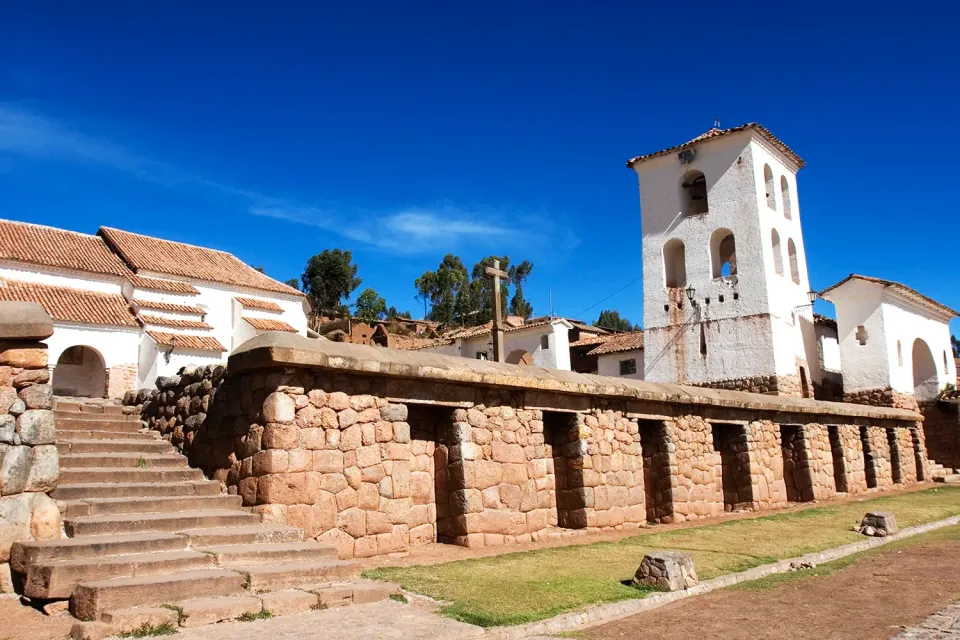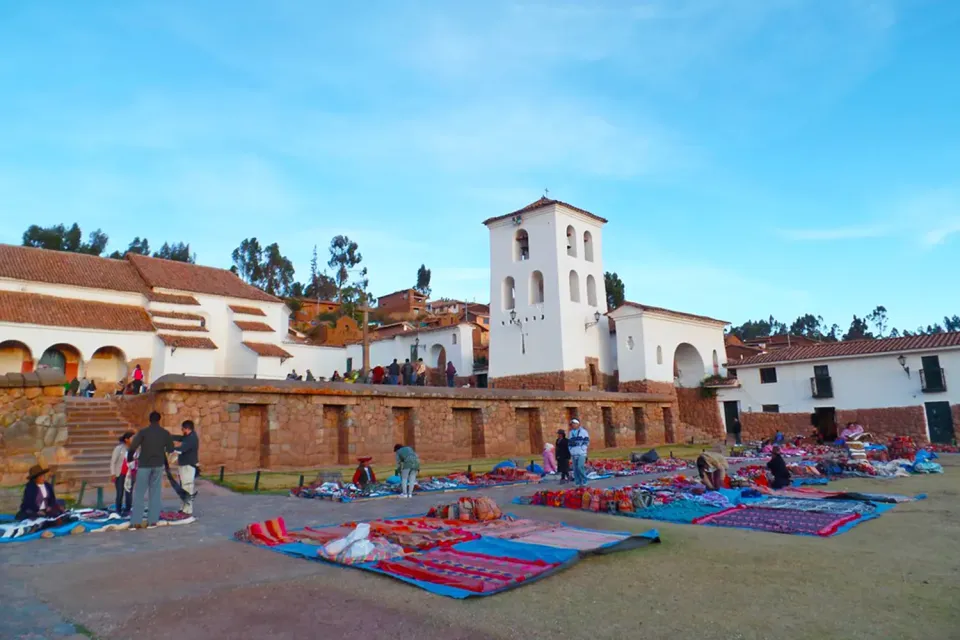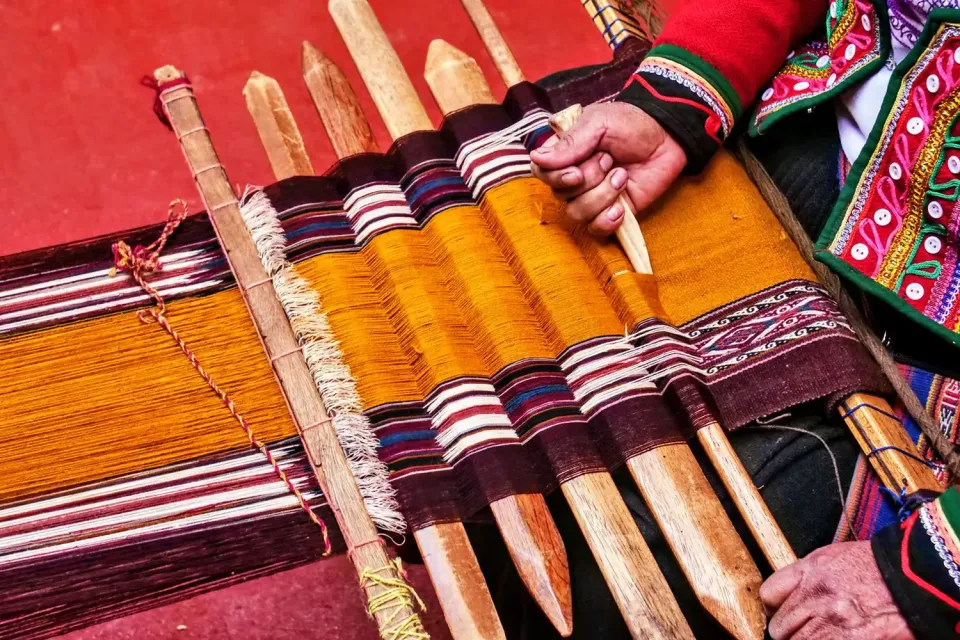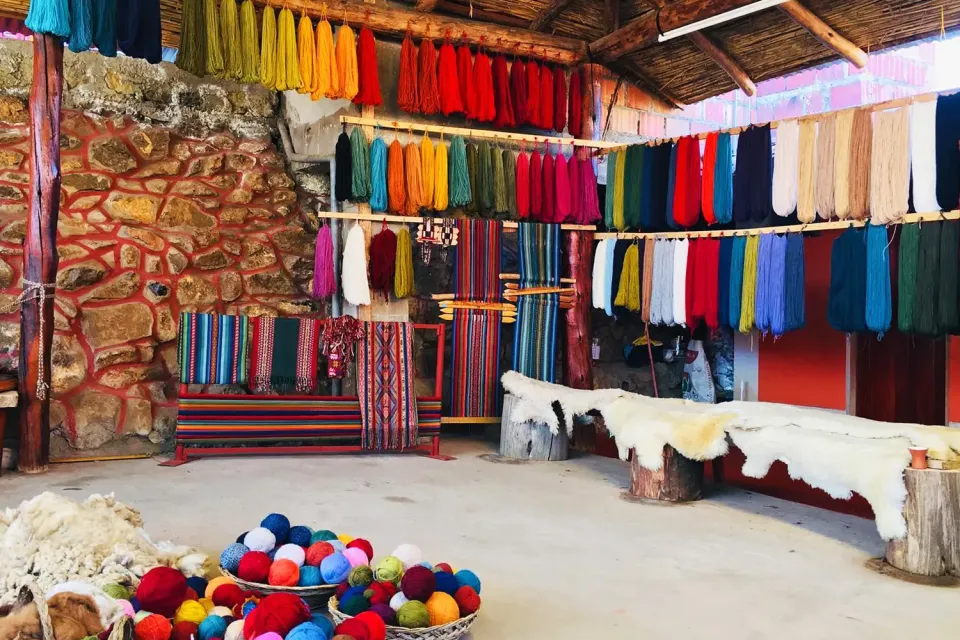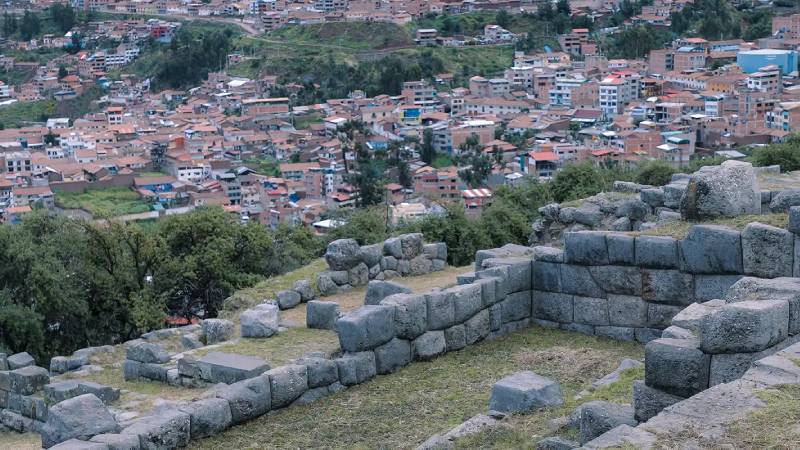In Chinchero Ruins, you will see many Inca structures. There are large rectangular buildings called Kallankas. You will also find canals, roads, wakas, terraces, and agricultural platforms. Each structure had a purpose in Inca life.
Chinchero is also known for its colonial temple. The Church of Monserrat was built over an ancient Inca structure. Today, it remains standing as part of the town’s historical heritage.
History of Chinchero
The archaeological site of Chinchero served as a residential, administrative, political, and religious center during the Inca era. Its name means Chinchay, which means feline. This animal was important in Andean culture.
Origins and the Inca Era
Two important ayllus lived in Chinchero. Ayllu Pongo settled in the south and southwest. Cuper Ayllu occupied the northeast. Both were part of the Ayarmacas, a pre-Inca ethnic group in the Cusco region. Today, their descendants still live in farming communities.
When the Tahuantinsuyo expanded, Túpac Yupanqui ordered the construction of Chinchero as his royal residence. These lands belonged to the Inca.
Later, the Incas fought against the Spanish. Manco Inca, while fleeing to Ollantaytambo, burned down the palaces of Chinchero. He wanted to prevent the invaders from taking supplies or capturing him. Before escaping, he fought a battle at Piuray Lagoon. Then, he decided to hide in the Vilcabamba jungle.
The Conquest and the Colonial Church
In 1533, the Spanish changed the organization of Chinchero. They imposed a new economic system and created orders. The most important one, Cuper Pongo, existed from 1549. Its first messenger was Alonso de Loayza.
In 1572, Viceroy Francisco de Toledo founded Nuestra Señora de Monserrate de Chinchero. The Spanish built a colonial church over an ancient Inca huaca (sacred sanctuary).
Today, Chinchero preserves a living culture. You can still see both Inca and colonial structures standing. Several farming communities remain organized just as they were in ancient times. Ayllu Pongo, Cuper Ayllu, and Yanaconas continue their traditions.
Textile craftsmanship is the town’s main activity. Artisans weave vividly colored blankets, all handmade with unique designs. These textiles are famous worldwide.
Chinchero Ruins
In Chinchero, you will see a large Inca plaza. You will also walk through terraced fields, ceremonial wakas, and ancient stone paths. You will find channels and drains used by the Incas. Plus, you will see a colonial church built on Inca foundations.
What You Will See There
The Great Inca Square of Capellanpampa
This rectangular square was a public space during Inca times, used for rituals and festivities. Three architectural structures, ramps, and staircases surround it.
Today, locals use this place for public and religious events, including civil parades and celebrations.
The Niches (Hornacinas)
This Inca wall has 12 large trapezoidal niches. It is located on the western side of the colonial temple. During the Inca era, it served as an altar for placing mummies and idols.
Chinchero's Main Square
This square is near the colonial church. Locals use it for community activities, where they display their traditional clothing and sell handmade textiles in a temporary market.
Montserrat Catholic Church
The Spanish founded this temple in 1607 and dedicated it to the Virgin of Montserrat. It was built over ancient Inca structures. Some believe that before the Spanish arrived, this place was a religious site or the residence of Túpac Inca Yupanqui.
The Wakas of Chinchero
Chinchero has several wakas (sacred places) and shrines. The most important ones are Pumaqaqa and Teteqaqa. These natural rock formations were destroyed by the Spanish during colonial times to prevent locals from continuing their worship.
Water Channels and Drainage Systems
Chinchero has several water systems. Some flow through squares and ramps, while others run underground beneath buildings.
The Agricultural Terraces (Andenes)
The Incas built stepped terraces to grow crops, mainly potatoes. This crop was the foundation of Chinchero’s economy and nutrition.
The Palace of Tupac Yupanqui
This complex served as an administrative and religious center. After the arrival of the Spaniards, much of the structure was destroyed, but it is still possible to see its original foundations and walls, which show the impressive Inca engineering.
Altitude Chinchero: How to Prepare?
Chinchero’s Altitude: 3,762 meters (12,343 feet) above sea level.
If you are not used to high altitudes, take it easy. Drink coca tea and rest upon arrival to avoid altitude sickness.
Climate: Semi-dry and mild, with an average temperature of 14°C (57°F).
🌤 From October to March (summer): Temperatures can rise to 22°C (72°F), but expect frequent rainfall.
🌤 From April to September (winter): Nights are cold, dropping to -5°C (23°F), but days are sunny with clear skies.
Best Time to Visit
If you want to see Chinchero with bright blue skies, the best time to visit Chinchero is between April and September. The weather is stable, it rarely rains, and you’ll enjoy sunny days.
On the other hand, if you visit during the rainy season (October to March), you will experience a different Chinchero. The landscapes turn greener, and you might even see a rainbow over the Andean sky.
Chinchero Peru Market: A Paradise for Textile Art Lovers
The chinchero market is a place where specialized hands weave stories in every thread. A corner where tradition never dies. Here the villagers exchange products and show their textile art to the world.
But only if you visit on the right days, you will see the artisans display their creations on hand-woven blankets.
Textile Art in Chinchero
Villagers dressed in traditional costumes display and sell colorful textiles created with ancestral techniques. Because each thread tells a story and each pattern reflects centuries of tradition. The skilled weavers of Chinchero use the backstrap loom, a tool inherited from generation to generation that allows them to make very detailed weavings.
This method, which dates back to Inca times, consists of attaching one end of the loom to the weaver's waist and fixing the other to a stable point. In this way, the proper tension is achieved to intertwine the threads with precision, allowing the fabric to take shape in a uniform and detailed way.
In chinchero, natural sheep, alpaca and vicuña fibers are used, with alpaca being the softest and most delicate. These fibers are hand-spun with great skill to produce high quality yarns. In addition, the vibrant colors of the textiles are achieved through natural dyes extracted from local plants, roots or insects.
- Blue: tarwi flowers.
- Yellow: qolle flower.
- Green: chilca and eucalyptus leaves.
- Brown and beige: moss.
- Purple: purple corn.
- Red and fuchsia: cochineal insect (also used in paints).
To make colors last, they use Maras salt, lemon, children's urine, and volcanic stone. This keeps fabrics bright for years.
The Meaning Behind the Designs
Chinchero textiles reflect the Andean worldview. Each symbol carries a message:
- Circles: puma eyes and Chinchero’s lakes.
- Diamond shape: ancient storage for sacred goods.
- S-shapes: Inca farming tools.
- Peaks: the condor, a sacred Andean bird.
Weaving takes 25 to 60 days, depending on size and design. Each piece is unique, made with patience and ancestral knowledge.
How to Get to Chinchero and What Else to Visit Nearby
So you can get to Chinchero, with two options depending on the time and experience you are looking for.
Transportation options from Cusco
Main route: This is the fastest and most direct. You only have to follow the paved road Cusco - Urubamba. It is 28 km long and in a short time you will be in Chinchero.
Secondary route: If you want to enjoy more of the road, you can go through the Sacred Valley. You will pass through Sacsayhuaman, Pisac, Calca and Urubamba before reaching Chinchero. It is a longer route, but with incredible views.
Places to Visit Near Chinchero
When you visit Chinchero, you can explore amazing places nearby. Each one offers something special. Here are some spots you shouldn’t miss!
- Chinchero Museum: The museum is in the main square of Chinchero. Here, you will see artifacts found during excavations. The space is big, and you can walk around to learn about the history of the site.
- Textile Production Centers: Local artisans create beautiful textiles in workshops called Aguana Cancha. You can watch them weave, learn about their techniques, and even try weaving yourself. If you like, you can buy handmade textiles at fair prices.
- Huaypo Lagoon: This lagoon sits near sacred mountains. Many birds and fish live here. It’s a peaceful place where you can enjoy nature.
- Piuray Lagoon: Piuray is the largest lagoon in Chinchero. It provides water to Cusco, making it very important for the region. The view is beautiful, and you can relax by the water.
- Pocpoc Waterfall: This waterfall is over 50 meters (164 feet) long. Locals and visitors love coming here. The water falls with great force, creating an incredible sight. If you like nature, this is a place you will enjoy.
Adventure sports in Chinchero that you can do
Chinchero is also an ideal destination for adventure lovers. Thanks to its varied geography and impressive landscapes, it offers diverse outdoor activities for those seeking excitement and contact with nature.
Hiking and trekking
The surroundings of Chinchero have hiking trails that connect with other archaeological sites and Andean villages.
Original Inca trails, panoramic views of the Sacred Valley and the possibility of exploring ancient agricultural terraces make this activity one of the most popular.
Mountain biking
Chinchero's terrain is perfect for mountain biking enthusiasts. There are routes that descend into the Sacred Valley, combining dirt roads, Inca trails and spectacular scenery. This activity is ideal for those seeking adrenaline and a physical challenge.
ATVs
Chinchero has extensive countryside and mountain scenery that can be explored on ATVs. If you are touring the Sacred Valley, an excellent option is to request an ATV tour from Chinchero to the salt mines of Maras and then on to Moray.
This experience will allow you to enjoy the adrenaline while crossing impressive Andean landscapes.
Paragliding and hang gliding
This activity takes place on Sacro Hill, the highest part of Chinchero, which makes it an excellent launching point for paragliding and hang gliding.
From the heights, you can enjoy breathtaking views of the Andean mountains, fertile valleys and Inca ruins. Weather conditions are usually favorable, making it an unforgettable experience.
How to buy your ticket to Chinchero
Where to buy the entrance ticket?
To visit Chinchero you need the Cusco Tourist Ticket. This ticket can be purchased at the main office of COSITUC, at Av. El Sol 103, office 102 (tourist gallery). If you want to go early to buy your ticket, they are open from 8:00 a.m. to 5:30 p.m., Monday through Friday, and on Saturdays until noon. They also sell it at the entrance of several tourist sites.
The schedule for exploring Chinchero
The archaeological site is open every day, from 8:00 a.m. to 5:00 p.m. If you want to explore it calmly and avoid crowds, it is best to go early.
Tourist ticket prices
Access to Chinchero is included in the Cusco Tourist Ticket, which also gives you entrance to other sites in the Sacred Valley.
If you have more time and want to see everything: Integral Ticket (valid for 10 days).
- Foreigners: 130 dollars
- Peruvians: 70 soles
If you only want Chinchero and some other sites: Circuit 3 Ticket (valid for 2 days)
- Foreigners: 70 dollars
- Peruvians: 40 soles
If you only plan a short visit, Circuit 3 may be the best option.
What to bring to Chinchero
The weather in Cusco is uncertain. For a moment it can be hot in the sun and cold in the wind. To enjoy without worries, take with you:
- Comfortable, layered clothing. The weather changes quickly.
- Sunscreen and hat. The sun here is stronger than it looks.
- Sturdy shoes. The stone paths can be uneven.
- Camera or cell phone with good battery. You don't want to miss the opportunity to capture the magic of the place.
- Cash. The handicraft market has textiles and souvenirs you won't find anywhere else.
The Chinchero ruins in Peru await you. It is an experience that worth it, because you will be able to take pictures that you will love on instagram.


